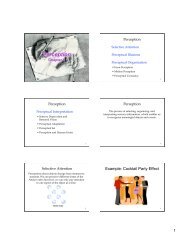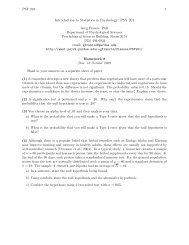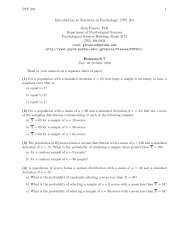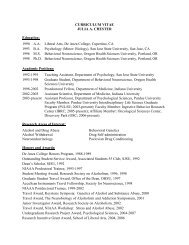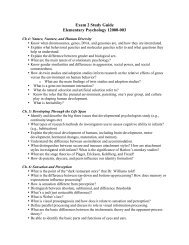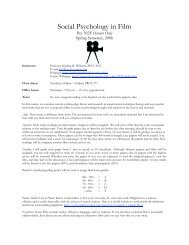Introduction to Cognitive Psychology - Department of Psychological ...
Introduction to Cognitive Psychology - Department of Psychological ...
Introduction to Cognitive Psychology - Department of Psychological ...
You also want an ePaper? Increase the reach of your titles
YUMPU automatically turns print PDFs into web optimized ePapers that Google loves.
Pr<strong>of</strong>essor Greg Francis 8/14/12Representation <strong>of</strong> mental imagesImagine you have a mental image <strong>of</strong> a lion If the mental image is a description (set <strong>of</strong>propositions), then it should include descriptiveinformation (head, mane, ears, whiskers,, tail,…)» size <strong>of</strong> body parts shouldnt matter much(except as information in the proposition)Representation <strong>of</strong> mental imagesImagine you have a mental image <strong>of</strong> a lion If the mental image is a depiction, then it shouldinclude fac<strong>to</strong>rs such as head, mane, ears, and theirsizes and relative positions» self reports <strong>of</strong> mental images suggest thedepicted version, but how <strong>to</strong> measureexperimentally?Purdue UniversityPurdue UniversityRepresentation <strong>of</strong> mental images Kosslyn (1976) Ask subjects <strong>to</strong> quickly answer questions like:» Does a lion have a head? (big body part)» Does a lion have claws? (small body part) subjects in two groups» 1) form a mental image <strong>of</strong> a lion» 2) think about a lion, but without a mental image Subjects forming a mental image respond more quickly <strong>to</strong> the headquestion than the claw question» presumably because the head is bigger in the mental imageRepresentation <strong>of</strong> mental imagesSubjects that did not form a mental image respond more quickly<strong>to</strong> the claws question than the head question presumably because the propositions about a lion having claws aremore accessible in some network <strong>of</strong> propositionsSo, different ways <strong>of</strong> thinking about a lion can lead <strong>to</strong> differentpatterns <strong>of</strong> access <strong>to</strong> information which implies mental images are different than propositions16001600Reaction time (ms)140012001000800600400200ImageryNo imageryReaction time (ms)140012001000800600400200ImageryNo imagery0SmallpartBig partPurdue University0SmallpartBig partPurdue UniversityMental rotationShepard & Metzler(1971) 3-D shapes rotated in plane or in depthCogLab experiment 163 participantsThe more rotated thestimuli are, the longerit takes <strong>to</strong> make aresponseMental rotation decide if shapesare same aredifferent close <strong>to</strong> linear increasein RT measure time <strong>to</strong>decidePurdue UniversityPurdue UniversityPSY 200: Intro. <strong>to</strong> <strong>Cognitive</strong> <strong>Psychology</strong> 3



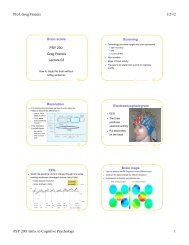

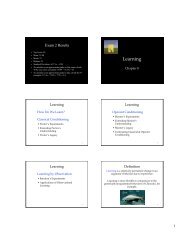
![Exam 4 Study Guide[1]](https://img.yumpu.com/45196739/1/190x245/exam-4-study-guide1.jpg?quality=85)
